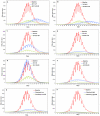Evaluating the combined effectiveness of influenza control strategies and human preventive behavior
- PMID: 22043275
- PMCID: PMC3197180
- DOI: 10.1371/journal.pone.0024706
Evaluating the combined effectiveness of influenza control strategies and human preventive behavior
Abstract
Control strategies enforced by health agencies are a major type of practice to contain influenza outbreaks. Another type of practice is the voluntary preventive behavior of individuals, such as receiving vaccination, taking antiviral drugs, and wearing face masks. These two types of practices take effects concurrently in influenza containment, but little attention has been paid to their combined effectiveness. This article estimates this combined effectiveness using established simulation models in the urbanized area of Buffalo, NY, USA. Three control strategies are investigated, including: Targeted Antiviral Prophylaxis (TAP), workplace/school closure, community travel restriction, as well as the combination of the three. All control strategies are simulated with and without regard to individual preventive behavior, and the resulting effectiveness are compared. The simulation outcomes suggest that weaker control strategies could suffice to contain influenza epidemics, because individuals voluntarily adopt preventive behavior, rendering these weaker strategies more effective than would otherwise have been expected. The preventive behavior of individuals could save medical resources for control strategies and avoid unnecessary socio-economic interruptions. This research adds a human behavioral dimension into the simulation of control strategies and offers new insights into disease containment. Health policy makers are recommended to review current control strategies and comprehend preventive behavior patterns of local populations before making decisions on influenza containment.
Conflict of interest statement
Figures


Similar articles
-
Strategies for mitigating an influenza pandemic.Nature. 2006 Jul 27;442(7101):448-52. doi: 10.1038/nature04795. Epub 2006 Apr 26. Nature. 2006. PMID: 16642006 Free PMC article.
-
Analysis of the effectiveness of interventions used during the 2009 A/H1N1 influenza pandemic.BMC Public Health. 2010 Mar 29;10:168. doi: 10.1186/1471-2458-10-168. BMC Public Health. 2010. PMID: 20346187 Free PMC article.
-
A small community model for the transmission of infectious diseases: comparison of school closure as an intervention in individual-based models of an influenza pandemic.PLoS One. 2008;3(12):e4005. doi: 10.1371/journal.pone.0004005. Epub 2008 Dec 23. PLoS One. 2008. PMID: 19104659 Free PMC article.
-
The risk of seasonal and pandemic influenza: prospects for control.Clin Infect Dis. 2009 Jan 1;48 Suppl 1:S20-5. doi: 10.1086/591853. Clin Infect Dis. 2009. PMID: 19067611 Review.
-
Antiviral agents for influenza: a comparison of cost-effectiveness data.Pharmacoeconomics. 2005;23(11):1083-106. doi: 10.2165/00019053-200523110-00003. Pharmacoeconomics. 2005. PMID: 16277546 Review.
Cited by
-
Effects of media on preventive behaviour during the COVID-19 pandemic.Humanit Soc Sci Commun. 2023;10(1):58. doi: 10.1057/s41599-023-01554-9. Epub 2023 Feb 14. Humanit Soc Sci Commun. 2023. PMID: 36818040 Free PMC article.
-
The impact of contact patterns on epidemic dynamics.PLoS One. 2017 Mar 14;12(3):e0173411. doi: 10.1371/journal.pone.0173411. eCollection 2017. PLoS One. 2017. PMID: 28291800 Free PMC article.
-
Decreased Risk of Influenza in Child and Adolescent Patients with Attention-Deficit Hyperactivity Disorder Following Methylphenidate Treatment: A Nationwide Cohort Study in Taiwan.Neuropsychiatr Dis Treat. 2020 May 21;16:1309-1319. doi: 10.2147/NDT.S242519. eCollection 2020. Neuropsychiatr Dis Treat. 2020. PMID: 32547034 Free PMC article.
-
Determinants of receiving the pandemic (H1N1) 2009 vaccine and intention to receive the seasonal influenza vaccine in Taiwan.PLoS One. 2014 Jun 27;9(6):e101083. doi: 10.1371/journal.pone.0101083. eCollection 2014. PLoS One. 2014. PMID: 24971941 Free PMC article.
-
The role of non-pharmaceutical interventions on influenza circulation during the COVID-19 pandemic in nine tropical Asian countries.Influenza Other Respir Viruses. 2022 May;16(3):568-576. doi: 10.1111/irv.12953. Epub 2022 Jan 8. Influenza Other Respir Viruses. 2022. PMID: 34997697 Free PMC article.
References
-
- Ferguson NM, Fraser C, Donnelly CA, Ghani AC, Anderson RM. Public Health Risk from the Avian H5N1 Influenza Epidemic. Science. 2004;304:968–969. - PubMed
-
- CDC. Updated CDC Estimates of 2009 H1N1 Influenza Cases, Hospitalizations and Deaths in the United States, April 2009–April 10, 2010. Atlanta: Centers for Disease Control and Prevention; 2010.
-
- CDC. Preventing Seasonal Flu. Atlanta: Centers for Disease Control and Prevention; 2008.
Publication types
MeSH terms
Substances
LinkOut - more resources
Full Text Sources
Medical
Miscellaneous

